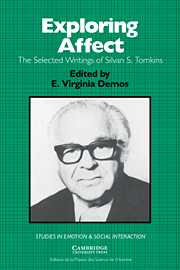Book contents
- Frontmatter
- Contents
- Foreword
- Editor's preface
- List of contributors
- Chronology
- Introduction
- Part I Affect theory
- Introduction
- Selections by Silvan S. Tomkins
- Part II Affect and ideology
- Introduction
- Selections by Silvan S. Tomkins
- Part III The face of affect
- Introduction
- Selections by Silvan S. Tomkins
- Part IV Script theory: The differential magnification of affect
- Introduction
- Selections by Silvan S. Tomkins
- The rise, fall, and resurrection of the study of personality
- Script theory
- Revisions in script theory – 1990
- The varieties of shame and its magnification
- Part V Human being theory: A foundation for the study of personality
- Introduction
- Selections by Silvan S. Tomkins
- A complete annotated bibliography of Silvan S. Tomkins's writings
- References
- Author index
- Subject index
- Titles in the series
The varieties of shame and its magnification
Published online by Cambridge University Press: 10 November 2010
- Frontmatter
- Contents
- Foreword
- Editor's preface
- List of contributors
- Chronology
- Introduction
- Part I Affect theory
- Introduction
- Selections by Silvan S. Tomkins
- Part II Affect and ideology
- Introduction
- Selections by Silvan S. Tomkins
- Part III The face of affect
- Introduction
- Selections by Silvan S. Tomkins
- Part IV Script theory: The differential magnification of affect
- Introduction
- Selections by Silvan S. Tomkins
- The rise, fall, and resurrection of the study of personality
- Script theory
- Revisions in script theory – 1990
- The varieties of shame and its magnification
- Part V Human being theory: A foundation for the study of personality
- Introduction
- Selections by Silvan S. Tomkins
- A complete annotated bibliography of Silvan S. Tomkins's writings
- References
- Author index
- Subject index
- Titles in the series
Summary
I regard shame as an affect auxiliary, and as a theoretical construct, rather than an entity unambiguously defined by the word “shame.” Our languages of communication are rough-hewn devices, sometimes coarse and sometimes marvellously subtle, reflecting insights and purposes of past cultures, which in part continue to be vital to the present, but in part to be alien and irrelevant.
If one were to trace the varying meanings of the word “shame” over the past few thousand years, one would illuminate the rich textures of the varieties of cultural mentalité rather than find this primary human feeling to be a fundamental invariant. A word in ordinary language may or may not confer the precision necessary for a scientific language. Thus, to write “salt” is not the same as to write “NaCl” or “sodium chloride,” especially since both sodium and chloride may be combined with other elements to make compounds for which the word “salt” might not be as useful a name. Nonetheless “salt” may “do” as a rough equivalent of sodium chloride so long as one does not insist that potassium chloride is “salt” or is entirely different from table salt.
Similarly, the common word “shame” will be adequate for my needs as a rough equivalent of the theoretical entity referring to a specific affect auxiliary. It is important for one to understand that the word shame (today) refers more to feelings of inferiority than feelings of guilt, and therefore more to responses of proving oneself “good” (in the sense of being superior) than to responses of proving oneself “good” in the moral sense.
- Type
- Chapter
- Information
- Exploring AffectThe Selected Writings of Silvan S Tomkins, pp. 397 - 410Publisher: Cambridge University PressPrint publication year: 1995
- 1
- Cited by



